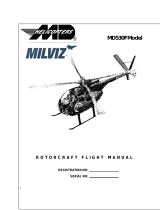190-01150-16 Rev. E RFMS Garmin G500H as installed in Bell 206L-1
Page 10 of 27 FAA APPROVED
Section 2. NORMAL PROCEDURES
Refer to the Garmin G500H PFD/MFD System Cockpit Reference Guide P/N
190-01150-03 or G500H Pilot’s Guide P/N 190-01150-02, for detailed operating
procedures. This includes all Primary Flight Display and Multi-Function Display
information.
Although intuitive and user friendly, the G500H PFD/MFD System requires a
reasonable degree of familiarity to avoid becoming too engrossed at the expense
of situational awareness. Pilots should take full advantage of training tools to
enhance familiarity with the G500H system.
• Review displays for any abnormal warning, caution, or advisory
indications
• If equipped with a terrain warning system, ensure that the terrain
alert audio test can be heard clearly
2.1 PFD Knob & PFD Soft Keys
The basic PFD controls are adjacent to and beneath the PFD display. The rotary
knob performs the function annunciated on the display just to the upper left of
the HSI: HDG, CRS, ALT, V/S, or BARO. If no function is annunciated, the
knob is providing a HDG function. Assigning the function of the knob is done by
pressing/releasing one of the dedicated function buttons adjacent to the PFD.
The knob defaults back to HDG if it is not rotated for a period of 10 seconds.
The Garmin G500H PFD/MFD System Cockpit Reference describes each
function and its operation.
The soft keys at the bottom of the PFD display are used to configure the course
data displayed in the HSI (CDI button, 1-2 button) and select the optional
bearing pointers (BRG1 and BRG2 button) which may be overlaid in the HSI
presentation on the PFD. The soft keys operate by press and release.
The ATT SYNC soft key synchronizes the miniature aircraft symbol to the
horizon line at the time it is pressed. Pressing the soft key again will return the
miniature aircraft symbol to its zero reference. When ATT SYNC is active
small marks will appear at the outboard edges of the attitude display that show
the zero reference.
The units and markings on the PFD are not user configurable. They match the
units as specified in the aircraft’s FAA approved Rotorcraft Flight Manual and
standby instruments. Display and control of the airspeed references are made via
the AUX page of the MFD; consult the Garmin G500H Cockpit Reference
Guide for description and operation of these references.
2.2 MFD Knobs & MFD Soft Keys
The MFD controls are adjacent to and beneath the MFD display. The rotary
knobs are used to scroll through various pages/page groups of the MFD.
Pressing the knob will activate a cursor and allow for the user to enter data and
manipulate settings.






















